

Precipitation can cause sudden temperature decreases. Most sensors record daily variations that reflect temperature differences between day and night. Interpreting the temperature data collected by these sensors requires careful analysis. Stream channel monitoring gives an indication of what is happening in the overall geyser basin, especially in terms of environmental conditions-for example, sudden decreases in temperature due to rainfall events. Tracking the temperature of pools, like Porkchop and Opalescent, provides a sense of whether new inputs of hot water might be occurring.

At Norris, temperature sensors monitor Steamboat, Constant, and Echinus geysers. Measuring the temperature in geyser outlets allows for easy recognition of geyser eruptions-increases in temperature likely mean that the geyser has erupted. The temperature sensors are situated in three different types of environments: geyser outlets, pools, and streams.
Best cpu temp monitor reddit 2017 download#
The once-per-day download is meant to conserve battery power, but the sensors, individually or collectively, can also be downloaded on an as-needed basis at any time. From there, the data are uploaded to the Internet and posted to the YVO website for public viewing. Temperature data are collected every 2 minutes, and once a day the data are downloaded to a base station located near the Norris Museum. The sensors are carefully hidden under boardwalks or in vegetation, so unless you know where to look it is doubtful that you would ever notice the stations. Each station consists of a datalogger with a radio antenna and a thermal probe and is powered by batteries that will last for nearly 2 years. With funding provided by the American Recovery and Reinvestment Act (ARRA) in 2009, a system of 10 temperature monitors was installed at the Norris geyser basin in the summer of 2010. Map of locations for temperature measurement sites in Norris Geyser Basin, Yellowstone National Park


 0 kommentar(er)
0 kommentar(er)
